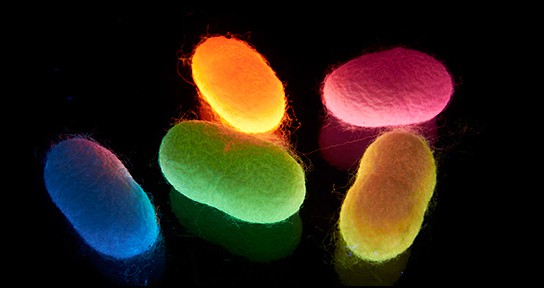
(image credit: IMRE)
dyeing of silk to get the color you want might be a thing of the past, as the team of scientists in Singapore have created silkworms that can produce vibrantly colored and luminescent silks. these colored silk generating silkworms are the result of feeding the silkworms with a mulberry mixture containing fluorescent dye. the silk created by these laboratory silkworms are not only colored but also has luminescent or glowing properties.
having the silkworms producing colored silk is also significant in terms of environmentally friendliness as Euegne Low Ooi Meng, spokesperson for Institute of Materials Research and Engineering (IMRE) in Singapore, explains:
“the process provides a green alternative method of dyeing silk for the silk industry by reducing the vast amounts of water and dyes used in the labour-intensive conventional dyeing process.”
according to IMRE, this technology “is simple and cheap enough to be translated to an industrial scale.” aside from being environmentally friendly, this technology could open up doors to medical applications as Dr. Natalia Tansil, lead researcher behind the technology at the IMRE in Singapore, indicates the possibility of creating silk with antibacterial, anticoagulant and anti-inflammatory properties that could be used in wound dressing or to repaired damaged tissues. with this in mind, a silk wound dressings with the the capability of monitoring and sensing wouldn’t be far-fetch at all.
silk is a natural protein fiber which are widely used to create a lustrous, strong and yet reflective textiles. silk fabric was first developed in ancient China with history dated as far back as 3500 BC. China remains the largest producer of silk textiles followed by India being the second largest silk producers. Silk has long been considered as a luxury textile and still admired for its unique properties today.

